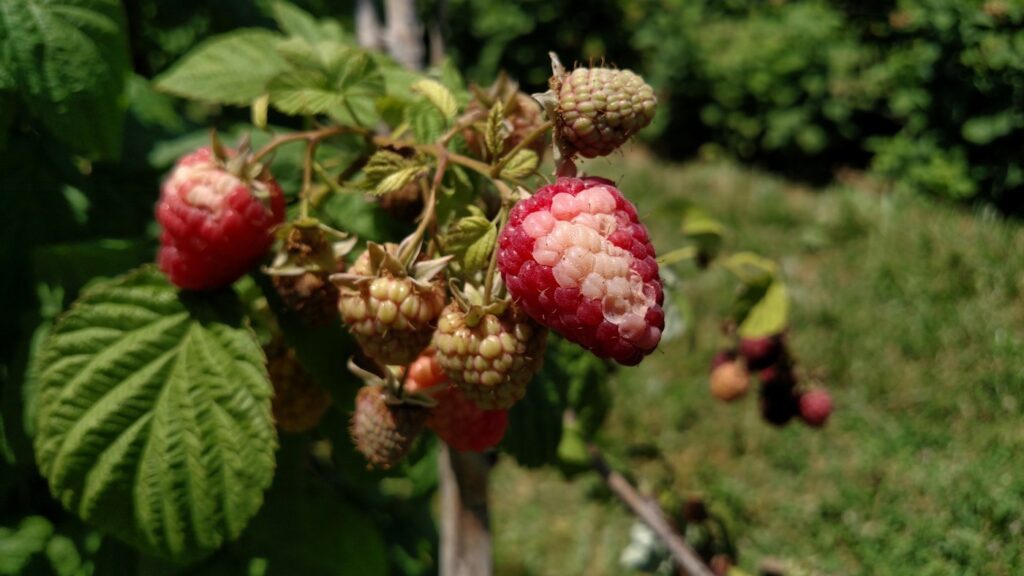Garden Q&A: Why did raspberries have white patches?
- December 21, 2023

Q: I got inspired to try growing raspberries after visiting a pick-your-own farm this past summer. Some of the berries had pale patches on the fruit. Is this avoidable for my future harvest?
A: This is fortunately a comparatively simple issue among fruit tree and shrub problems, and when not extensive, doesn’t render the fruit useless. It’s called “white drupelet disorder,” and is essentially a sun-scalded or sunburnt section of the fruit. Drupes are the individual compartments of pulp around a single seed that form the aggregate fruit we call a berry in bramble plants like raspberry and blackberry. It’s the ultraviolet (UV) light in sunlight that is causing cellular damage in the fruits. Circumstances that increase the risk of sunscald include hot, dry, breezy weather – all conditions that speed up plant water loss.
To avoid white drupelet disorder at home, you can give plants a bit of partial shade, either from a structure covered in 30% shade cloth or from nearby structures or taller plants. (In a garden of edible plants, that could come from an elderberry shrub or serviceberry tree.) Don’t shade raspberries too heavily, though, as good sun exposure is otherwise needed for maximum berry production and shrub vigor.
Q: When do I stop watering my garden plants? I have heard when frosts begin, but that it should continue into winter. If plants aren’t growing during winter, why do they need checking?
A: Even though plants aren’t growing above ground in winter, roots might be growing slowly when the soil temperatures are mild, and the plant is still using water to stay alive, just at a slower pace than during warm weather.
While there isn’t a one-size-fits-all rule for plant care concerning watering, in general, hardy plants in the garden should be monitored for watering needs any time of year when precipitation is inadequate. This is especially important for evergreens since their foliage will continue to lose moisture during winter (even if not photosynthesizing much), particularly in conditions of full sun or mild temperatures, breezy days, and low ambient humidity.
An inch of rain per week is the goal for the growing season, but less is probably sufficient for the dormant season. Keep in mind that snow isn’t as “wet” as we may think it is for gardens, though it’s still a great insulator against cold injury for perennial crowns and shrub stems. According to NOAA, about 13 inches of snow (on average) is equivalent to one inch of rain. For quick mental math, you can round this to about a one-tenth ratio: a snowfall of a certain amount equals about a tenth of that in rain. (Two inches of sleet may equal about one inch of rain.)
A damaging combination of a sudden warm-up of air temperature, while the soil surface is still frozen, raises the risk of winterburn – what is essentially freezer-burn damage that foliage cannot recover from, even if its symptoms don’t appear right away. In that situation, roots can’t access frozen water to absorb in order to replace what the foliage is losing, so desiccation injury results. At best, this only kills some foliage that the plant will shed and replace in spring; at worst, it kills branches and likely roots as well, requiring more time and energy for the plant to replace and stagnating growth in the meantime. Young plants that are still establishing, which won’t have as extensive a root zone as more mature plants, should top the list when monitoring the landscape for irrigation.
Granted, you can’t water when the hose is frozen, so check the roots during mild spells and water plants then as needed; you can use cool or tepid water in a watering can from a sink inside. Just like during summer, feel the soil several inches deep in the root area, and if it’s becoming somewhat dry to the touch, water well unless it’s a species that really wants to get quite dry between waterings. Some species, like summersweet (clethra) and buttonbush (cephalanthus), won’t tolerate getting too dry during winter or their branches could die back, but others, like yucca and prickly-pear (opuntia), are less picky and more tolerant of being fairly self-sufficient as long as they are established. Plants in containers will dry out faster than plants in the ground, and the potting mix will also freeze and thaw more rapidly.
Unfortunately for gardeners, desiccation damage on plants that got too dry at some point during winter might only manifest in spring, long after any possibility of intervention.
University of Maryland Extension’s Home and Garden Information Center offers free gardening and pest information at extension.umd.edu/hgic. Click “Ask Extension” to send questions and photos.
Most Viewed
More
- AandE
- Allegheny
- Books
- Celebrities
- Celebrity News
- Editors Picks
- Health Now
- Local
- MLB
- Monroeville
- More A and E
- Most Recent Obituaries
- Movies TV
- Murrysville
- Music
- News
- News & Advice
- NFL
- NHL
- Norwin
- Penn Hills
- Pirates
- Pittsburgh
- Plum
- Politics Election
- Sports
- Steelers
- Theater Arts
- Top Stories
- Tribune Review Obituaries
- US-World
- Valley News Dispatch
- Westmoreland
- World